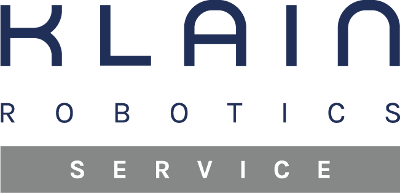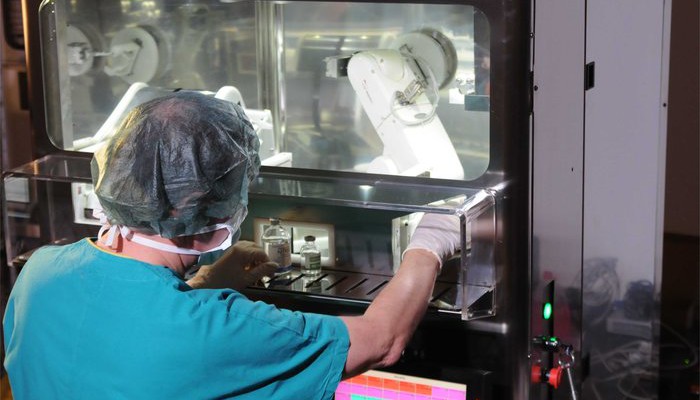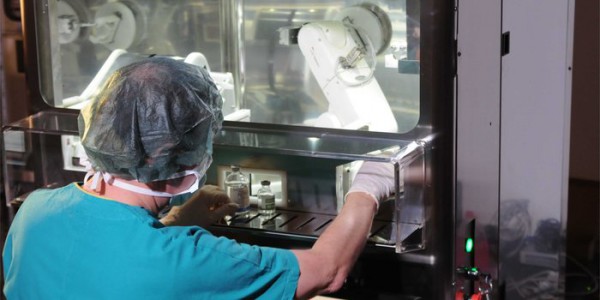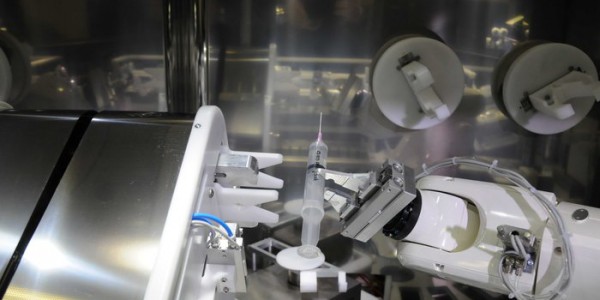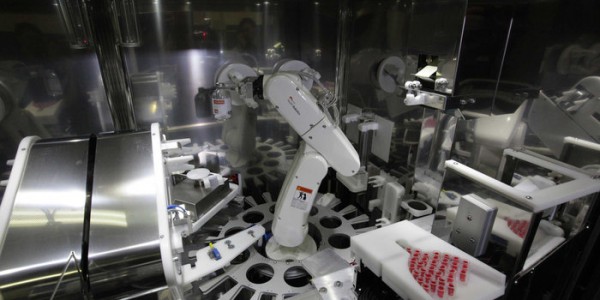Company: HEALTH ROBOTICS
Industry: Medical
DENSO Products Used: VP-G2-S1 (H2O2-resistant)
Company Location: Italy
Website: http://www.health-robotics.com/en/
THE PROBLEM
To develop a very compact and flexible system able to manipulate a large variety of objects (i.e.: drug vials, syringes, and IV bags of different shapes and dimensions) that are normally used in the manual process of drugs compounding.
THE SOLUTION
Against this background the i.v. Station emerged, based on a DENSO robot – that could be described as a type of automated medicine distribution system, which is connected to the hospital prescription system. The appliance receives its order data from the prescriptions for the treatment specific to the patient. This information includes the medicine preparations that have to be made available in a selected time period and in a special form. At the point in time that a new bottle, a new syringe or a new bag is introduced almost nothing on the machine’s hardware has to be changed. It is enough to readjust the software or the modalities to handle and administer the object. Among others the i.v. Station allows the preparation of medicines such as antibiotics, painkillers and anti-inflammatories for inpatient treatments.
- A DENSO 6-axis robot of the VP-G2 series takes the syringe and positions it on a mechanical dosing feeder.
- Then it takes the top off the syringe and takes the bottle that has to be filled with the medicine out of the repository, which had previously checked by an image processing system.
- After the needle has drawn off the desired quantity the robot lifts the syringe into the weighing system.
- A gravimetric check is carried out there that makes it possible to make an independent check of the dosage. During these procedures the machine is continually provided with a constant air flow that guarantees sterility in the interior. This system guarantees that the air is completely exchanged practically every two seconds.
- Before discharging, the syringe is provided with a protective cap so that the contents do not come into contact with the outside air. Then it is labelled by the labelling machine, which provides information about the medicine preparation and a barcode for identification purposes.
To avoid errors when filling materials the i.v. Station has two image processing systems with medium resolution cameras (three megapixels). These check if the bags and syringes have been correctly positioned and they also scan the bottle labels that appear to prevent the operator from accidentally confusing the medicines during the filling phase. This is supplemented by a control phase – which takes place during filling – that is done by a barcode reader placed on the front panel of the machine. The final check is done by the computer monitoring system, but through the barcode reader the machine already knows what to expect.
Great attention has been paid to the dimensions of the equipment, because there is normally little space in hospitals. “Large equipment,” emphasises Giribona, “means nothing less than sacrificing part of the market, because many hospital do not have enough space to install it. It is for precisely this reason that we drafted the i.v. Station to be the size of a large fridge, a cuboid one metre by two metres high that can be easily set up.” The compact design of the DENSO robot met this aim.
Safety has top priority
To be able to guarantee an appropriate safety level in terms of functionality and operator access the i.v. Station is equipped with certain capabilities. For example, it guarantees that access by unauthorised people is prevented during working procedures. These measures extend from profiling the user using user names and passwords, reader modules to identify RFID badges, up to biometric recognition.
